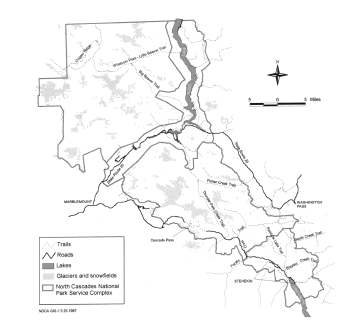|
North Cascades
Threatened and Endangered Species |

|
THE NORTH CASCADES ECOSYSTEM
|
Ecologists define the North Cascades ecosystem by patterns of geology, watershed, vegetation and wildlife and encompasses more than 11 million acres. The greater North Cascades ecosystem stretches from tide water on the west to the dry Okanogan River Valley on the east; from Washington's Snoqualmie Pass on the south to the Canadian Similkameen and the Fraser Rivers along its northern extent. Much of the land which defines this ecosystem is protected by the United States Forest Service, the United States National Park Service, and the Provincial Government of British Columbia.
North Cascades National Park Service Complex (NOCA) sits nearly in the center of 6 million acres of protected lands within the North Cascades ecosystem. Of these 6 million acres, 1.4 million have been designated wilderness by Congress. |
| <<< Previous | <<< Contents>>> | Next >>> |
noca/threatened-endangered-species/treas3.htm
Last Updated: 10-Nov-2016
